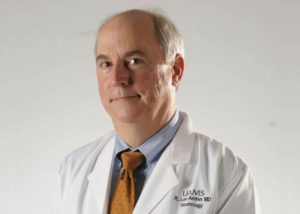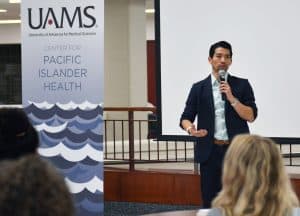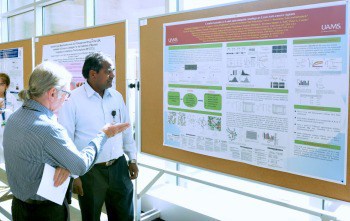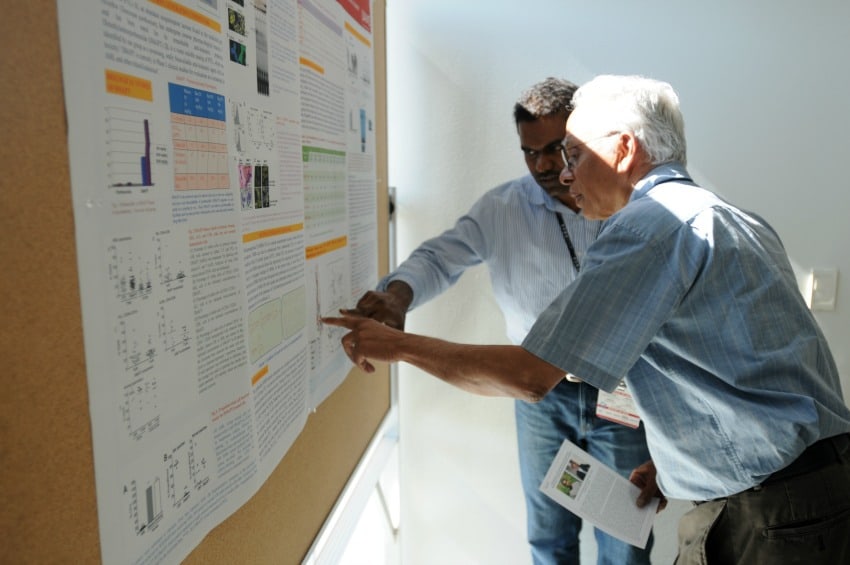July 27, 2017 | Robert L. “Lee” Archer, M.D., has been named chair of the Department of Neurology in the College of Medicine at the University of Arkansas for Medical Sciences (UAMS), effective Aug. 1.
Archer, who has lead the department on an interim basis since July 2016, has served on the UAMS faculty for more than 30 years, providing world-class care for Arkansans with multiple sclerosis (MS), while teaching and mentoring many future neurologists. He has earned the admiration of his patients, students, residents and colleagues.

“Dr. Archer emerged as the clear choice in our nationwide search for a leader who can take the department’s education, research and clinical programs to the next level,” said Pope L. Moseley, M.D., dean of the College of Medicine and executive vice chancellor at UAMS. “As interim chair, he embraced the significant challenges of leading a department in transition. The department has expanded substantially under his leadership, with his recruitment of nine outstanding physicians and scientists – half of the department’s current faculty.”
Two of those new faculty members were recruited to improve stroke and critical care services, one of Archer’s key areas of focus. Other goals include facilitating the efforts of the Movement Disorders Clinic, including collaborative work with the College of Medicine’s Department of Geriatrics and the UAMS Donald W. Reynolds Institute on Aging specifically in Alzheimer’s disease, and building on the already strong Multiple Sclerosis Clinic by supporting faculty research.
Archer also will focus on strengthening ties with the basic science faculty at UAMS, particularly in bioinformatics, to fully take advantage of research, education and collaboration opportunities. He will advance the department’s research into amyotrophic lateral sclerosis (ALS) by filling two endowed chair positions in association with the Department of Pharmacology and Toxicology. He will continue to work closely with the UAMS Department of Neurosurgery to ensure patients receive seamless care from diagnosis to surgery to follow-up care.

“I think any leader wants to bring out the strengths in the group, so I want to facilitate the careers of the talented people we have here and bring in more talented people to expand on our strengths,” Archer said.
Archer, who is highly regarded in the MS patient community, will continue to spend about half of his time on patient care. He has trained and hired a second physician, Carolyn Mehaffey, M.D., to continue to serve MS patients in Arkansas and allow the UAMS MS clinic to accept new patients.
Archer received his medical degree from the College of Medicine in 1982. He completed his residency at UAMS, joined the faculty in 1986 and has held the rank of professor since 2008. He founded UAMS’ Multiple Sclerosis Service in 1987 and co-directed the Muscular Dystrophy Association Clinic at UAMS from 1989 to 2003.
This month Archer will conclude 13 years of service as chair of the University Hospital Medical Ethics Advisory Committee. He has served on many other institutional panels, including the College of Medicine Promotion and Tenure Committee, which he chaired in 2016-2017.
Archer is president-elect of the Arkansas Medical Society. He is also active in the National Multiple Sclerosis Society and several civic organizations. He has served on the Board of Directors for the Arkansas Regional Organ Recovery Association (ARORA) since 2005 and chaired the organization in 2014-2016.
Among many honors, Archer was invested in 2007 as the inaugural holder of the Major and Ruth Nodini Chair in Neurology, which was established with $1 million in donations to support his clinical care, research into MS and educational programs. One initiative partially funded by the endowment is the MS Fellowship developed and led by Archer, which graduated its first fellow — new faculty member Mehaffey — this past June.
Graduating College of Medicine seniors have awarded Archer three Gold Sash and numerous Red Sash awards for his teaching. He received the Distinguished Faculty Award from the College of Medicine Alumni Association in 2007. In 1999 he received the inaugural Humanism in Medicine Award for faculty in the college. He received the UAMS Helen May Compassionate Care Award in 2015 and was honored later that year as the Physician of the Year in the Arkansas Business Health Care Heroes ceremony. Among many “Best Doctors” recognitions he was voted in 2010 as the Best Neurologist in Arkansas and featured on the cover of the Arkansas Times.
Archer has been married to his wife, Nancy, for 40 years.
“Like anyone who is successful in life and in their career, I have a spouse to thank,” Archer said. “She has been the person to encourage me and keep me inspired to keep learning and growing throughout my career.”
UAMS is the state’s only comprehensive academic health center, with colleges of Medicine, Nursing, Pharmacy, Health Professions and Public Health; a graduate school; a hospital; a northwest Arkansas regional campus; a statewide network of regional centers; and seven institutes: the Winthrop P. Rockefeller Cancer Institute, the Jackson T. Stephens Spine & Neurosciences Institute, the Myeloma Institute, the Harvey & Bernice Jones Eye Institute, the Psychiatric Research Institute, the Donald W. Reynolds Institute on Aging and the Translational Research Institute. It is the only adult Level 1 trauma center in the state. UAMS has 3,021 students, 789 medical residents and five dental residents. It is the state’s largest public employer with more than 10,000 employees, including about 1,000 physicians and other professionals who provide care to patients at UAMS, Arkansas Children’s Hospital, the VA Medical Center and UAMS regional centers throughout the state. Visit www.uams.edu or www.uamshealth.com. Find us on Facebook, Twitter, YouTube or Instagram.
###









